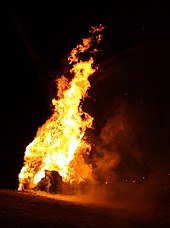Wicker man

A wicker man was a large wicker statue of a human used by the ancient Druids (priests of Celtic paganism) for human sacrifice by burning it in effigy, according to Julius Caesar in his Commentarii de Bello Gallico (Commentary on the Gallic War).[1][2]
In the modern world, wicker men are used for various events. The figure has been adopted for festivals as part of some neopagan-themed ceremonies, without the human sacrifice element.[3] Effigies of this kind have also been used as elements in performance art, as display features at rock music festivals, as thematic material in songs, and as the focal point of a cult British horror/mystery film, The Wicker Man. Much of the prominence of the wicker man in modern popular culture and the wide general awareness of the wicker man as structure and concept is attributable to this film.
History
Ancient
While other Roman writers of the time, such as Cicero, Suetonius, Lucan, Tacitus and Pliny the Elder, described human sacrifice among the Celts, only Caesar and the geographer Strabo mention the wicker man as one of many ways the Druids of Gaul performed sacrifices.[4] Caesar reports that some of the Gauls built the effigies out of sticks and placed living men inside, then set them on fire to pay tribute to the gods. Caesar writes that though the Druids generally used thieves and criminals, as they pleased the gods more, they sometimes used innocent men when no delinquents could be found.[5]
One medieval commentary, the 10th-century Commenta Bernensia, states that men were burned in a wooden manikin in sacrifice to Taranis.[6]
The ritual is similar to Indian festival of Dashehra the festival of victory of good over evil. On this day in the Treta Yug, Rama, also called Shri Ram, the seventh incarnation of Vishnu, killed the great demon Ravana who had abducted Rama's wife Sita to his kingdom of Lanka. The entire narrative is recorded in the epic Ramayana. There are outdoor fairs and large parades with effigies of Ravana, his brother Kumbhakarna, and son Meghanad. The effigies are burnt on bonfires in the evening.
Neopagan usage

Wicker men are set ablaze during some neopagan festivities. A female effigy of wicker or other materials is burnt at the stake for the annual Danish celebration of Sankt Hans aften (Saint John's Eve). Typically, Celtic neopagans, Neo-druids, or Wiccans are those who use such a motif in their festivities because they, unlike other neopagan groups, are either inspired by, or follow a reconstructed form of, Celtic paganism. At other times, neopagans do not burn wicker men, but keep them as idols for protection, often merging them with the Green Man. Neopagan wicker men range from life sized to huge, humanoid, temporary sculptures that are set ablaze during a celebration, usually toward the end of the event. They are constructed with a wooden frame that is woven with flexible sticks such as willow often used in wicker furniture and fencing. Some wicker men are extremely complex and require days of construction.[7]
Modern
The Wickerman Festival is an annual rock and dance music event that takes place in Kirkcudbrightshire, Scotland; its main feature is the burning of a large wooden effigy on the last night.[8]
The Northern Italian version of the wicker man is called La vecchia ("the old lady") which is burned once a year as part of town festivals. However, it has a more Christian connotation since it is burned on Mid-Lent Thursday, as depicted in the film Amarcord by Federico Fellini.
Popular culture

In 1973, a British horror film was produced titled The Wicker Man, directed by Robin Hardy. The film tells the story of a devout Christian policeman played by Edward Woodward who uncovers the malevolent secrets of a sinister pagan cult on a remote Scottish island. He is then burned alive within a huge hollow wicker man. The film's denouement involves a wicker man effigy. An American remake of the film produced by Boaz Davidson starring Nicolas Cage was released in 2006 with the story being set on a private island in Puget Sound, Washington.
The set for Iron Maiden's 2000 Brave New World tour featured a large mechanical wicker man as part of the special effects as a reference to their song "The Wicker Man", based on the 1973 film.
In addition, since 1986, an effigy of a man has been burned during the Burning Man festival.
See also
- Willow Man, a permanent Wicker man sculpture in England
References
- ^ Caesar, Julius; Hammond, Carolyn (translator) (1998). The Gallic War. The Gallic War, p. 128. ISBN 0-19-283582-3.
- ^ "Did The Celts Burn Human Sacrifices In A Huge 'Wicker Man'?", The Straight Dope, 1998
- ^ Wicker-Man: The Burning Question. Retrieved October 23, 2006.
- ^ Lugodoc's Guide to Druids
- ^ De Bello Gallico 6.16
- ^ Mircea Eliade, A History of Religious Ideas, Vol. 2. University of Chicago Press (1982). § 171.
- ^ Wickermanburn.org
- ^ Gallery, Thewickermanfestival.co.uk
External links
- Caesar, De Bello Gallico, English translation by W. A. McDevitte and W. S. Bohn (1869); Latin text edition, from the Perseus Project
- Project Gutenberg text for Frazer's The Golden Bough
